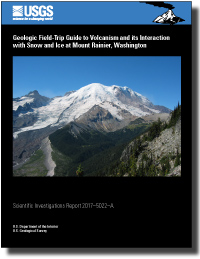Geologic Field-Trip Guide to Volcanism and its Interaction with Snow and Ice at Mount Rainier, Washington
Links
- Document: Report (45 MB pdf)
- Larger Work: This publication is Chapter A of Field-trip guides to selected volcanoes and volcanic landscapes of the western United States
- Download citation as: RIS | Dublin Core
Abstract
Mount Rainier is the Pacific Northwest’s iconic volcano. At 4,393 meters and situated in the south-central Cascade Range of Washington State, it towers over cities of the Puget Lowland. As the highest summit in the Cascade Range, Mount Rainier hosts 26 glaciers and numerous permanent snow fields covering 87 square kilometers and having a snow and ice volume of about 3.8 cubic kilometers. It remains by far the most heavily glacier-clad mountain in the conterminous United States despite having lost about 14 percent of its ice volume between 1970 and 2008.
Five major rivers head at Mount Rainier—the White, Carbon, Puyallup, Nisqually, and Cowlitz Rivers. Because Mount Rainier is situated west of the Cascade Range crest, all of these rivers eventually turn and drain westward. The Puget Lowland, situated west to northwest of Mount Rainier, is the Pacific Northwest’s most densely populated area, including Seattle, Tacoma, and Olympia. The Puget Lowland is now home to a population of more than 4.5 million and a vibrant economy.
Mount Rainier is one of the most hazardous volcanoes in the United States, not so much because of its explosivity, but rather because of its frequent eruptions, its propensity to produce voluminous far-traveled lahars, and its proximity to large population centers of the Puget Lowland. Steep-sided, glacially carved valleys serve as lahar conduits, and even mild eruptions commonly produced large lahars that traveled into areas now populated by hundreds of thousands of people.
This guide describes a five-day field trip to view the geology of Mount Rainier as it relates to volcanism and its interaction with snow and ice. Day 1 will focus on lahars in the White River valley. We will drive to Enumclaw, Washington, to begin the day then work our way back upvalley toward Mount Rainier. Day 2 concentrates on geology of the Sunrise-Glacier Basin area within Mount Rainier National Park. As part of day 2 activities, we will hike about 10 miles from Sunrise to the top of Burroughs Mountain, down into Glacier Basin, and be picked up at White River Campground. On day 3 we will pack up and move to Paradise, stopping to examine geology along Stevens Canyon Road. We will hike from Paradise along the Golden Gate Trail and eventually eastward to the former Paradise Ice Caves area (the ice caves have melted out). Day 4 involves hiking from Comet Falls trailhead to Mildred Point and return (~7 miles; 11 km), examining geology along the way. During the first half of day 5, we will visit sites on the south side of Mount Rainier to study lahar deposits, then return to the tour origin.
Suggested Citation
Vallance, J.W., and Sisson, T.W., 2022, Geologic field-trip guide to volcanism and its interaction with snow and ice at Mount Rainier, Washington: U.S. Geological Survey Scientific Investigations Report 2017–5022–A, 76 p., https://doi.org/10.3133/sir20175022A.
ISSN: 2328-0328 (online)
Study Area
Table of Contents
- Introduction
- Tectonic Setting
- Regional Geology
- Holocene Volcanism of Mount Rainier
- Volcano Hazard Assessments and Mount Rainier
- Field Trip Itinerary and Field Stop Descriptions
- Acknowledgments
- References Cited
| Publication type | Report |
|---|---|
| Publication Subtype | USGS Numbered Series |
| Title | Geologic field-trip guide to volcanism and its interaction with snow and ice at Mount Rainier, Washington |
| Series title | Scientific Investigations Report |
| Series number | 2017-5022 |
| Chapter | A |
| DOI | 10.3133/sir20175022A |
| Publication Date | November 10, 2022 |
| Year Published | 2022 |
| Language | English |
| Publisher | U.S. Geological Survey |
| Publisher location | Reston, VA |
| Contributing office(s) | Volcano Science Center |
| Description | Report: xi, 76 p. |
| Country | United States |
| State | Washington |
| Other Geospatial | Mount Rainier |
| Online Only (Y/N) | Y |


